Austria - From Graz to Salzburg
- Walter Blattmann
- Aug 12
- 13 min read
For the first time, Tamara and I are traveling in Austria with the camper. Wellness weekends and ski vacations in 1987 are our only experiences with our neighboring country so far.

Second largest city in Austria - Graz (2.8.25)
Just as the Limmat divides the city in Zurich, the Mur flows through the middle of Graz. The old town is approximately the same size, and the buildings are impressive.
There is a noteworthy explanatory plaque for a street name "Abraham a Santa Clara." The street designation was the order name of the Augustinian monk and writer Johann Ulrich Megerle 1644-1709. "As a poet of the Baroque, he created an extensive body of work in lyric and prose. In it, and in his hate sermons, he attacked Jews, but also Turks and Protestants." It is alarming what kind of people streets, alleys, or bridges are named after. In Zurich, we have the Rudolf Brun Bridge on the topic of Jewish history.The buildings of bakeries and coffee houses date back almost to the Middle Ages. Correspondingly, the old facades are fascinating.
In every corner and street, we find creative buildings, shops, sculptures, and signage. Wordplays and wisdom can be found throughout the city.
The castle and the castle hill "tell" stories about the Reformation and various wars with the French and Germans. For example, the 38-meter high bell tower was built as a prison for the Protestants. Next to the bell tower are the walls of the Protestant Thomas Chapel from the year 1271.
Der Tombstone from the year 1387 of Rabbi Nissim, a traveling Jewish merchant, was found in the castle. Interesting is the date on the tombstone, which is calculated according to the Jewish calendar (no new era before or after Christ): Thursday the 10th of the month of Tammuz in the year 147 of the 6th millennium. According to biblical genealogical tradition, the dating is based on the creation of the first humans.
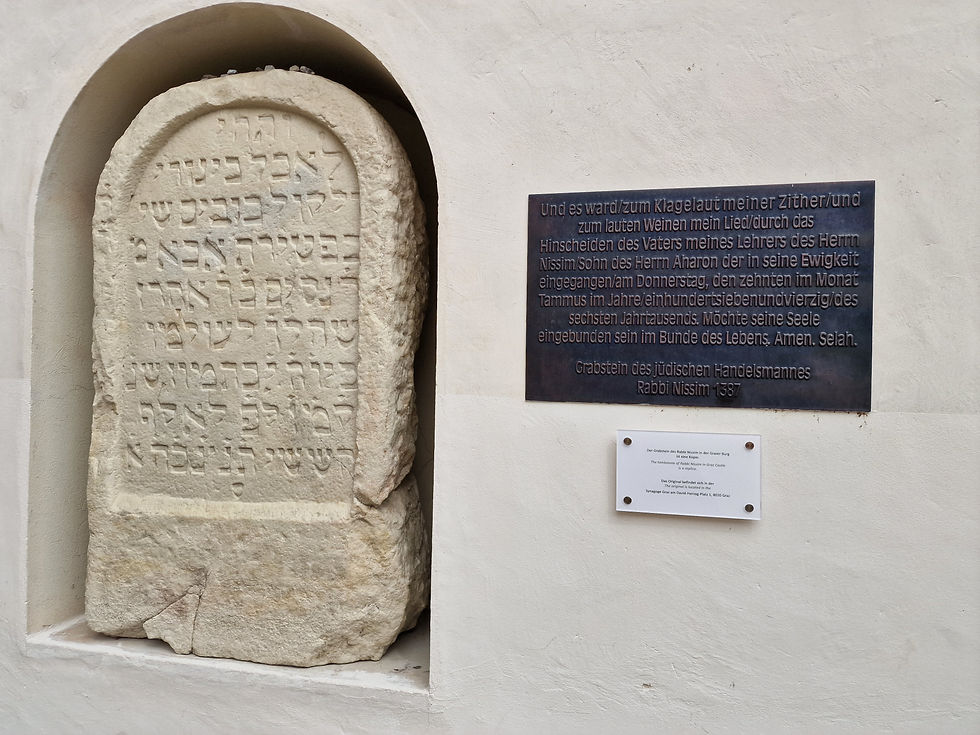
The stairs in the castle are also very interesting. If you take the left staircase at the entrance, you will meet the person who took the right staircase on the first floor. This creates an exciting pattern and interesting architecture.

The cathedral and the Church of the Holy Sepulchre (Kaiser Ferdinand II and his wife Maria Anna) as well as the image of the Plague of God are very exciting traditions and buildings.

The Bild of God's Plagues from 1480 depicts the suffering of the people of Graz, who were afflicted by the Turks, locusts, and the plague in that year. In the center, the Trinity (Father, Son, and Holy Spirit) sits enthroned, punishing sinful humans with hunger, illness, and war. On the left, the prophets stand, and on the right, Mary and the saints, who stretch a cloth of intercession to prevent all punishments from falling upon the people. I have rarely seen such a theologically incorrect representation. It saddens me that the church has established a tool of power with religion, making us believe that we need saints and the church as intermediaries to God to protect us from punishment. According to the Bible, the opposite is true; God sent His own Son as an intermediary so that all who believe in Jesus and His forgiveness of sins may be saved. Jesus says of Himself: 'I am the way, the truth, and the life. No one comes to the Father except through me.' We cannot do anything ourselves to earn/buy a place in heaven. Jesus paid for the mistakes of us humans, and that is why all are justified who accept this gift in faith. However, it is a very personal decision whether one believes this or not.

We return to the sleeping place at the generational playground in Freikirch. By now, English and Polish visitors have also settled there with their campers.
Hike through Southern Styria to Slovenia (3.8.25)
Finally, we can participate in a church service in our language again. We find three free churches on the internet. The Evangelical Free Church Graz (EFG) reminds us of our church in Albisrieden. We arrive there at 10 o'clock. The sermon is about how the Gospel of Jesus has been proclaimed throughout human history. From Cain and Abel, Abraham, the Exodus from Egypt to the Second Coming of Jesus, he explains the connections to the act of redemption on the cross. Anyone interested can listen online: https://www.efggraz.at/.After church coffee, we set off to the wine road in Southern Styria. So to speak, from coffee to wine :-). On the way, we still need to fill up on water. Through the app mymizu, all drinking water supplies worldwide are listed to save plastic by allowing us to refill our bottles there.
About 1.8 km of the wine road runs directly along the Slovenian border. Often, the roads between Ehrenhausen, Grassnitzberg to Ratsch lead over beautiful hills with a view of the vineyards. Time and again, signposts invite you to taste at the well-maintained wineries. However, we do not want to stress the weight checks in Austria regarding campers over 3.5T with additional bottles. Therefore, we drive past with discipline.
Through the hiking app Komoot, we find a beautiful route through the vineyards. The panorama is stunning, and the weather is pleasant for hiking.

The hike lasts 1.5 hours and takes you through the vineyards, up and down the hills, sometimes we are in Austria and then back in Slovenia...

Wild blackberry bushes invite you to snack. Some grapes and plums are already ripe. Only the pears still need a bit more time.
We find our sleeping place again at a generational playground in St. Veit am Vogau. At such a playground, there are interesting play and sports equipment for all age groups. We sleep soundly until the next morning at 9 o'clock.
Bruck an der Mur (4.8.25)
We will set off at 11 o'clock. Our destination is the Green Lake. However, rain is forecast for the late afternoon. Therefore, we plan a stopover in Bruck an der Mur. The drive is entertaining and takes us through beautiful forests and idyllic hilly landscapes. We enjoy our lunch with a beautiful view.
On the way, we encounter billboards for Summa Gaudi, Ballermann Party, and Ibiza Party; here in Styria, the bear dances ;-). The roads are very narrow, and crossing is only possible at a slow pace. We notice that a lot of things are more strictly regulated here in Austria. For example, at the stop sign, it additionally says, "Please proceed to the stop line!" or at the roundabout, it states, "Signal when leaving the roundabout."Upon arriving in Bruck an der Mur, we park in a hiking parking area above the town. Today is not a good day for hiking, so we decide to set up camp here for the night. However, we want to explore the town first.
This place was settled 1000 years before Christ. Right by the river, there still stands a house where Celts and Illyrians sought shelter. Iron and salt were already being transported on the river back then. The Romans also used this strategic location by the water. Later, in the year 1263, a fortification wall and a castle were built on the hill. The prosperity is still visible today in the splendid buildings. Here is also the second largest village square in Austria and a parish church from the 12th century.
In the main square, we drink an aperitif and then go to the Schlossberg. From there, the view over the city can now be enjoyed without rain.
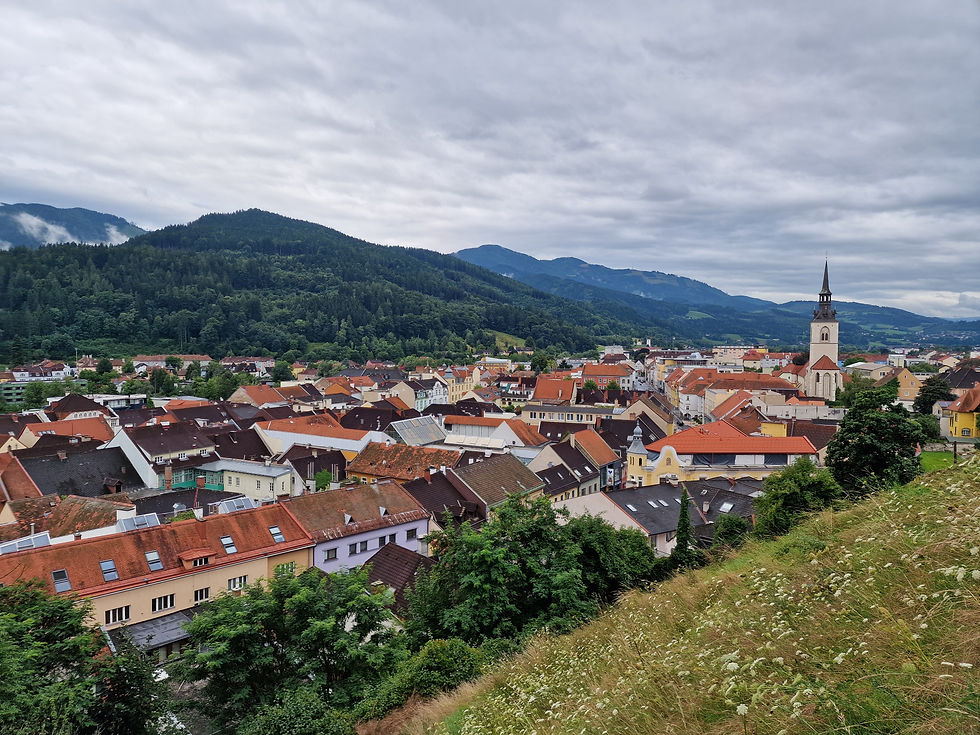
Tamara is cooking potatoes, zucchini, bell peppers, tomatoes, and onions topped with cheese in the Omnia oven tonight :-). We're going to bed early tonight.
Hike around the Green Lake (5.8.25)
At the Kreuzteich, we are already of the opinion that we have arrived at the Green Lake. Somehow, however, the hike was only short and the lake wasn't really green. Also, the description that the lake has a water depth 6-8 meters less at this time of year doesn't seem plausible to us.
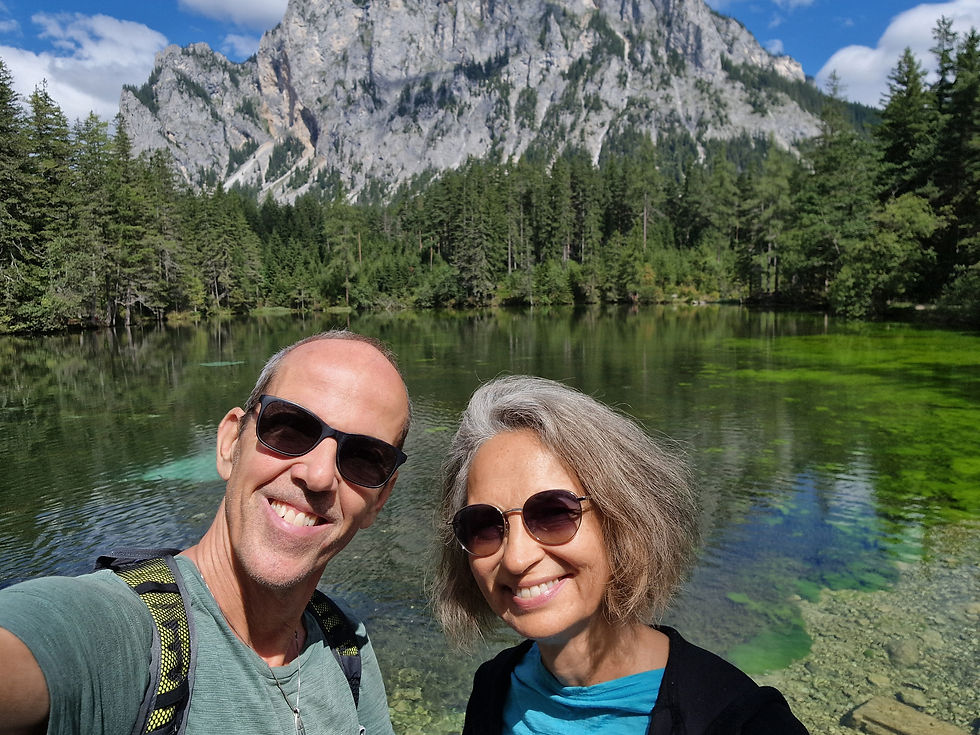
The green color comes from bushy, light green plants on the ground. Once sand is on the bottom, the water glows emerald green. Thank God the sun is shining today and the water truly stands out with its colors.
In the cross pond, large fish sunbathe in the sun. They come close to the shore and probably know that fishing is forbidden. The hiking trail continues further back, and through Google Maps, we can see that the Green Lake is only coming now. Right after the Seehof guesthouse, there is a right turn to the lake.

This lake is really green. The water comes directly from the melting snow in the mountains. That's why it is only really full in spring. Then many benches and bridges at the lakeshore are completely underwater.But where does the green color come from? The pure glacier water absorbs red light parts, which leads to the blue-green color. Finely crushed rock that is suspended in the water mainly reflects the blue-green parts of the light. This color is also recognizable in similar mountain lakes as 'glacier milk'.
After this "strenuous" hike, we stop at the inn and enjoy dumplings with spinach and white cabbage. Afterwards, I will quickly fly the drone before we continue.
The path takes us a stretch along the 123.5 km long B115 Iron Road. For several thousand years, iron ore has been mined in this area. At the town of Erzberg, a large mine is still in operation today on the Erzberg. Graz, Leoben, and Judenburg are now home to the largest steel mills. We pass by Voestalpine Steel Donawitz, and the plant appears endlessly long along the road. Austria is among the top 8 steel producers in Europe. The drive is entertaining.At Lake Trabocher, we take an aperitif on the park bench and plan our onward journey. Various options are up for discussion: Dachstein Glacier in Schladming or Hallstatt. When we read that the Chinese filmed a series in Hallstatt and that the town is a UNESCO World Heritage site, we realize that we won't be alone there. In 2012, a copy of Hallstatt was opened with an artificially created lake called 'Hallstatt See-Huizhou.' After only one year and 940... After just one year and 940 million USD, the Chinese company Minmetalls Corporation built a complete copy of Hallstatt. Those traveling in the southern Chinese region will find Hallstatt at the coordinates: ♁23° 10′ 38.9″ N, 114° 19′ 34.5″ O. Tomorrow will be an adventure because around 2000 buses visit this town in Austria every year and campers are not allowed.
Hallstatt (6.8.25)
Originally, we wanted to set the alarm for 7 AM and go to Hallstatt early before the tourist rush arrives. However, the night before, we decide to arrive later in the afternoon and do a hike beforehand. Before we leave, we take a long shower and have breakfast in the park at our sleeping spot.

Please do not draw hasty conclusions. The photo above is probably from the same place where we have breakfast, but the night before during the aperitif. :-)
Tamara is the best tour guide you can imagine. If you are looking for an optimized travel itinerary, just contact Tamara. We find the second-to-last parking spot in Puchen by Lake Altausee. There we leisurely have lunch and set off to circle the lake. The weather is fantastic and the view from the lakeside path (712 meters above sea level) of the Dach Glacier (2700 meters above sea level) is beautiful.

At the far end of the lake, we enjoy the view and a Kaiserschmarrn. It is our first Kaiserschmarrn that we eat and we are curious about what it actually is. I cannot say how it is made exactly. But it tastes super delicious!

A nice couple from Carinthia and Tyrol joins us and gives us a few Austrian tips for our trip. As in all populations, there are stricter and more sociable people. Today we meet very open and friendly people again. The hike around the lake usually takes only 1.5 hours. Tamara and I are taking it easy and enjoying the variety between Kaiserschmarrn, steep rock faces, reed landscapes, and white pebble beaches.
To optimize leisure enjoyment for every target group, 50% of the (narrow) circular hiking path is exclusively for walkers, without cyclists. This is regulated and clearly marked, as is the case with many things in Austria.

We once again thoroughly enjoyed it, and the circular hike took nearly 4 hours. Now we are heading to Hallstatt. Tamara found a free parking space in a tunnel, just above the village. Thank God there is a parking spot available for us!

In Hallstatt, there are always exciting information boards that Tamara finds and studies in detail. Thus, the smallest villages become real treasure troves. Here in Hallstatt is the oldest salt mine in the world. Salt has been extracted here for 7000 years. Even today, 300,000 tons are mined per year. However, the guided tour of the salt mine experience is already closed because it is already 6 PM.

Since the Chinese copy of the village in 2012, the village has been challenged to cope with the many tourists. Thus, we find various signs prohibiting bike parking, drone flying, noise while chatting, etc. With 2000 buses per year, this is very understandable. Even late in the evening, there are still some tourists bustling about in the village square.
The village is picturesque, and it is unimaginable how the Chinese rebuilt this village within a year. Again and again we find, or rather Tamara finds, an exciting information board: "Else Bergmann", "A House for the Poor" or "Fight for Faith". I am impressed by the biographies of people who were willing to pay a price for their beliefs and values.

Before saying goodbye to Hallstatt, a folklore band sings in a restaurant. The average age of the band is estimated to be 77 years. I would have been interested to know how long these people have been making music together.By the way, the Chinese even replicated the manhole covers accurately. It says beside the coat of arms, "Take care of what you love." How true!
Hike to the rear Gosau Lake to the Dachstein Glacier (August 7, 2025)
Early in the morning, we are already at the parking lot of the front Gosau Lake and eating our breakfast. It feels like being in Zurich at the (former) Grand Café on Limmatquai. Cars from all countries pass by our window. An endless stream of people is hiking up the mountain. Some carry climbing gear and helmets as if for a high-altitude tour. Others come in swimsuits with a SUP under their arm. We are uncertain about how to pack our backpack and then set off at 11:30 anyway. A few steps from the parking lot reveals a fantastic panorama.

The path is easy and leads us up around 300 meters in elevation to the back Gosau Lake. Families swim in the lake and climbers ascend the via ferrata with helmets and ropes on the rocks. Many also walk the path with strollers. You can't imagine a more idyllic landscape.
In the furthest valley, we have lunch in a beautiful mountain hut with interesting cows. The woman at the table asks us why we Swiss come to Austria for hiking. I tell her that the mountains here are much smaller and thus more chill to hike ;-). She only understands my humor a bit later when I really explain to her why we are here. After lunch, I want to take a selfie with a cow and lean down in front of the cow headfirst. The cow does not feel flattered but thinks that I want to eat her grass. Therefore, she bumps my bent head with her own. After the initial shock, the cow gets back up......, just kidding. We survive the collision, and the selfie doesn't turn out as nice as I had imagined.
At 6 p.m. we will be back at the car. Of course, this includes breaks for apple strudel and dumplings. The view and the hike with over 20,000 steps are highly recommended.
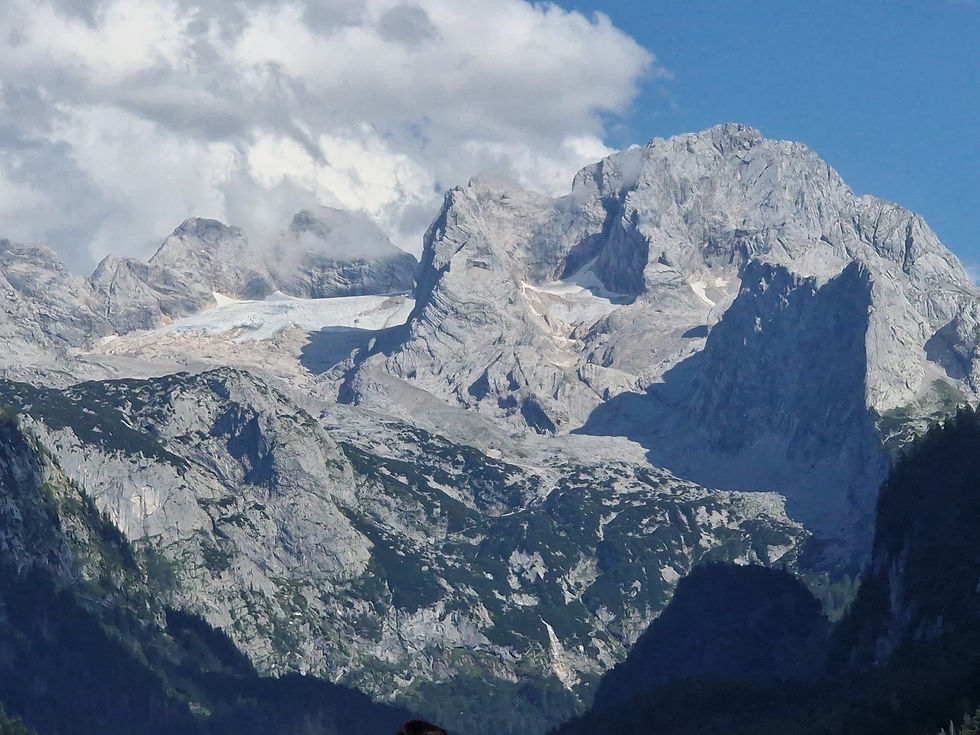
Fuschl Lake (8.8.25)
In the morning, a butterfly greets me. It keeps landing on me, and I feel special. It is the first butterfly that has landed on me. It's a shame that my leg hair is depicted more sharply in the photo than the butterfly :-))

On the way to Salzburg, we pass by Fuschl am See. There is the headquarters of Red Bull, right by the road to the bathing area Stöllinger.

Lake Fuschl is one of the cleanest lakes in Austria. The color is between turquoise and petrol, creating a calm and relaxed atmosphere. The SUP is inflated and Tamara and I are enjoying it very much. Tamara stays a little longer, much longer. It is really delightful here.

Salzburg (9.8.25)
In Salzburg, we park right by the old town. The blue zone is valid for 3 hours, and from 4 PM on Saturday, parking is free. The city has a lot to offer. Currently, the summer festival is still on, so the city is quite busy. First, we go to the cemetery because it is right behind the church at the entrance to the old town. Tamara and I then walk around and read the inscriptions on the gravestones, or rather, the memorials. Four things stand out to me. The first memorial shows a dying person with an hourglass, and the names range from 1635 to 2017. 40% of the plaque is still free for all the names of descendants. Secondly, I notice that around 80% of the gravestone surface is used for titles, roles, and functions. As if that somehow has an impact on eternity. Thirdly, there are emotional graves that offer hope. For example, the grave with the inscription "TO THE UNFORGETTABLE MOTHER" and a Bible verse of hope "The sufferings of this present time are not worth comparing with the glory that is to be revealed to us" from Romans 8:18. The fourth one is rather sad and makes me thoughtful. They are large gravestones with only the name and birth-death dates on them. This means 90% of the space is just empty! I remember a sermon in the 90s with the question of what will be written on our gravestone one day. Or what the survivors should remember about us. Good question and a cemetery worth visiting. Mozart is also buried there, as he was born and died in Salzburg.
The Getreidegasse runs parallel to the Salzach River. Salzburg is divided by the river and is surrounded by hills and mountains on which castles, fortresses, and manors rise. The parallel streets are connected by arcade walks in all shapes. The houses are inscribed on the rooftops with the year of construction and renovation.

In this city, you will find boutiques, galleries, bakeries, traditional costumes (which are also worn on the streets), Mozart balls, and much more. In a knife shop, I saw a handcrafted Japanese knife for over 25,000 euros.In this city, art and architecture are celebrated. It is a pleasure to stroll through the streets and be inspired.
We do not shy away from climbing the rocks. Earlier buildings from Salzburg were hewn directly from this rock. The quarry is now a tourist attraction and can be accessed from the Mönchsberg.

The oldest bakery St. Peter dates back to the 12th century and still bakes bread with the original oven. The water wheel of the mill is also in operation and is supplied by the 400-meter-long mountain tunnel. Here in Salzburg, traditions are maintained and culture is nurtured.

"Religiosity" is omnipresent in Salzburg. Time and again, there is a stimulus that encourages reflection. For example, there is a puppet hanging next to the altar in the Kollegienkirche. What does that evoke in you? In a private garden, there is a cross and a sign that asks you to remove your hat if you believe in Jesus. There is also a lot of superstition that shapes everyday life. Personally, I find these stimuli valuable. Ultimately, death, the meaning of life, and eternity concern us all.
Sunday in Salzburg (August 10, 2025)
We slept near the ICF Salzburg because we want to attend the service at 11:30 AM. In any case, we are exceptionally 30 minutes too early. Or unfortunately 30 minutes too late. The service actually started at 10:30... After the initial frustration, we listen to the sermon that is now just beginning online on the way to the Grossglockner High Alpine Road.


















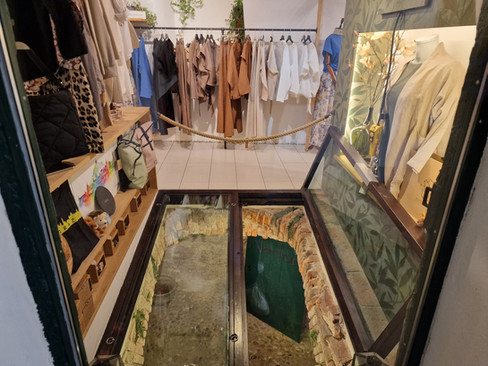
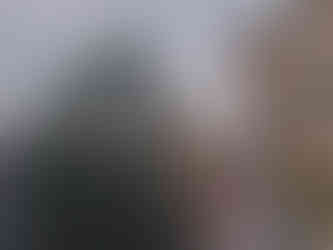























































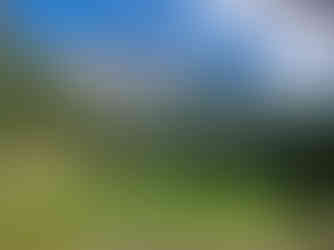





















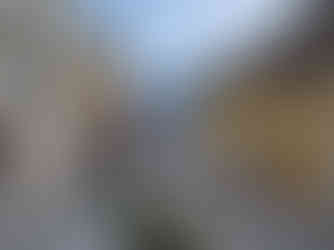










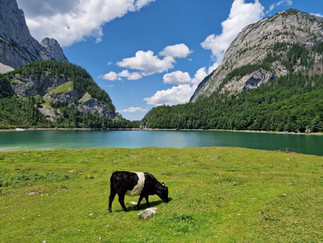
















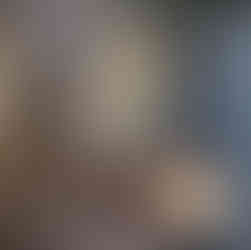






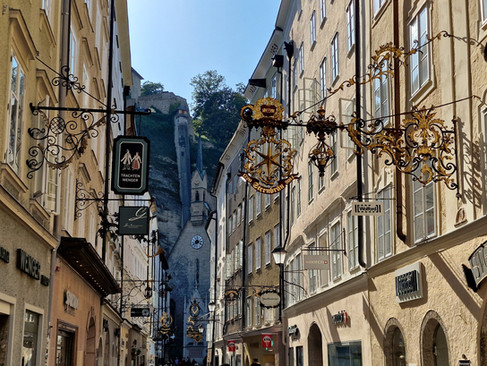
















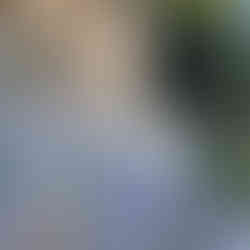




Comments